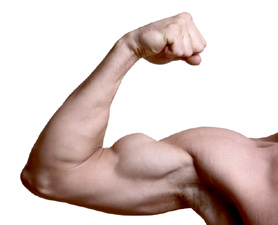Scientists develop Terminator-style artificial muscles
Now this is some serious muscle.
Scientists in the United States have built a robotic muscle that can be up to 1,000 times as powerful as a human one, the US Department of Energy's Lawrence Berkley National Laboratory said.
It said the muscle is 1,000 times more powerful than a human muscle, and can catapult objects 50 times heavier than itself over a distance five times its length within 60 milliseconds.
“We’ve created a micro-bimorph dual coil that functions as a powerful torsional muscle, driven thermally or electro-thermally by the phase transition of vanadium dioxide,” said head researcher Junqiao Wu, a physicist who holds joint appointments with Berkeley Lab’s Materials Sciences Division and the University of California-Berkeley’s Department of Materials Science and Engineering.
The device, technically known as a microscale torsional muscle/motor, the robotic muscle uses vanadium dioxide to throw or push away an object.
Vanadium dioxide crystals also undergo a temperature-driven structural phase transition - when warmed, they contract along one dimension and expand along the other two.
"Already prized for its extraordinary ability to change size, shape and physical identity, vanadium dioxide can now add muscle power to its attributes," the lab said.
Vanadium dioxide is also coveted in the electronics industry as it is among the few known materials that can be an insulator at low temperatures and a conductor at 67 degrees Celsius.
A team with the Lawrence Berkeley National Laboratory (Berkeley Lab) demonstrated the micro-sized robotic torsional muscle/motor.
“Using a simple design and inorganic materials, we achieve superior performance in power density and speed over the motors and actuators now used in integrated micro-systems,” Wu said.
Wu wrote a paper describing the technology. Co-authors include Kai Liu, Chun Cheng, Joonki Suh, Robert Tang-Kong, Deyi Fu, Sangwook Lee, Jian Zhou and Leon Chua.
Also, Wu noted miniaturizing rotary motors is important for integrated micro-systems.
He said the power density of their micro-muscle "distinguishes it from all current macro- or micro-torsional actuators/motors.”
Wu also noted multiple micro-muscles can be assembled into a micro-robotic system that simulates an active neuromuscular system.
"The naturally combined functions of proximity sensing and torsional motion allow the device to remotely detect a target and respond by reconfiguring itself to a different shape. This simulates living bodies where neurons sense and deliver stimuli to the muscles and the muscles provide motion,” he said.
The rise of complex organisms
A separate article on RT.com said this can open doors for scientific progress being made almost exponentially, as micro-muscles could be combined to form a more complex organism.
“This simulates living bodies where neurons sense and deliver stimuli to the muscles and the muscles provide motion,” Wu said.
But for now, RT.com said the researchers believe it is still too early to start fearing a Terminator-style rise of the machines, "as the mechanism in question is currently the size of a microchip." — TJD, GMA News
Source: http://ph.news.yahoo.com/
Subscribe to:
Post Comments (Atom)


No comments:
Post a Comment